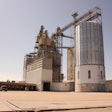
It’s been a decade since PEDv was discovered lurking in animal feed. Will the technology of the future render animal feed virus free?
A trip around the world is, for most people, a once-in-a-lifetime event. But when Kansas State University professor and veterinarian Jordan Gebhardt received an invitation to travel to Vietnam in mid-2019, he had reason to believe this trip would be particularly momentous — and not just for him.
By this point, the world already knew that viruses, particularly porcine epidemic diarrhea virus (PEDv), could spread in animal feed. And there was evidence from the lab that African swine fever (ASF) could also survive in feed, but it was not yet clear whether the virus was circulating in real-life feed mills.
Six months after ASF reared its ugly head in Vietnam, Gebhardt received an invitation to test a Vietnamese feed mill for the presence of the virus. There was no reason to believe this particular feed mill had a problem — the mill’s operators just wanted to check for potential holes in their biosecurity measures, Gebhardt recalls.
“This was already a very biosecure system, a very modern system, with lots of good things in place,” Gebhardt says.
Yet ASF had, in fact, already made its way into the facility. The majority of the samples came back clean, but a handful collected from the outside of the feed mill trucks — less than 1% of the total samples — contained the virus. Additional samples from the loading area found the inside of the truck cabs themselves contained the highest concentrations of virus.
“One of the big findings for us was people movement and truck movement were the biggest areas where we could find” ASF virus, Gebhardt says.
The trouble with viruses, experts say, is that once they find their way into a feed mill, they can be incredibly difficult to get rid of. So preventing the entry of a viral contaminant remains the primary goal, he says. But options for decontamination are increasing.
Preventing contamination
As the case of the Vietnamese feed mill demonstrates, Gebhardt says, human error remains the primary source of viral entry into the feed mill. Although the drivers were not supposed to leave the cab of their truck while dropping off feed at the farm, a bit of investigation quickly determined that the truck drivers had not observed this rule.
“There is a social component of that, because your co-workers are doing all the manual labor and you’re sitting in the cab, so some of those drivers were getting out and helping their colleagues unload,” Gebhardt says. “Except that, in some cases, they were bringing ASF back into that cab.”
Research within controlled environments has yielded similar findings, Gebhardt says. Researchers at Kansas State University have recreated a feed mill environment within a biosecure laboratory in order to study how ASF spreads within the mill. Some surfaces remain clean throughout the experiment. But the one place they’ve been able to find ASF virus every time they’ve sampled, Gebhardt says, is on the workers’ shoes.
“People movement is really, really important with the transmission of this pathogen,” he says.
The good news on this front is that a majority of feed mills have already made strides toward managing the flow of people in their facilities in order to prevent the spread of pathogens, according to Scott Dee, a veterinarian and director of research at Pipestone Veterinary Services, where he focuses on viral transmission, antibiotics resistance and biosecurity.
“What we have learned is that most likely the feed mill gets contaminated when the feed truck comes in from a farm, and the farm has some disease, and the truck can drive it right into the mill,” he says. “And typically what happens as they unload their trucks into those underground pits is people end up sweeping spilled feed or any debris that came off the truck into the pit and that contaminates the feed below.”
Far more attention is paid to this issue today, Dee says. Feed trucks are now often sanitized and barriers added to prevent materials spilled while unloading from entering the facility. Ideally, new feed mills would be built with separate driveways for entry and departure, he says, but existing facilities can achieve some of the same protection by marking the direction of travel for incoming and outgoing product on the floor, and by installing dry footbath powders — wet baths lose efficacy over time — at high-risk entry points.
“Dry footbath powders are easy to implement, hand sanitizer is easy to implement,” Dee says. “Putting some emphasis on that, no matter how your feed mill is designed, is something you can do.”
The other way a virus may enter a feed mill is through the feed ingredients themselves, Dee says. Some viruses, including ASF, have been found to persist within feed ingredients for extended periods of time — long enough they may survive transoceanic voyages. But this too can be mitigated by separating incoming ingredients from outgoing product, Gebhardt says. Holding ingredients imported from high-risk areas in designated quarantine areas for expended periods of time may also help reduce the viral risk.
“We know the practices,” Gebhardt says, “it’s just implementing them.”
The advent of COVID-19 may actually help increase worker compliance in the future, Gebhardt says. Now that the world has seen how quickly a deadly virus can spread, he says, it may be easier to communicate to workers that ASF, too, is a devastating disease that requires personal as well as industrywide vigilance.
Feed mill decontamination
Unfortunately, even with the strictest biosecurity measures in place, it’s unlikely a feed mill will completely eliminate the potential for viral contamination, Gebhardt says. And once a virus does enter, it tends to spread in a medium feed mills readily supply: dust.
Contaminated dust, Dee says, poses a significant risk because it has the potential to introduce cross-contamination even if a feed mill maintains separate pathways for incoming and outgoing ingredients and personnel. This is why researchers at Kansas State University are investigating possible strategies for feed mill decontamination.
“One of the questions that has arisen is if we have a feed mill test positive for one of these viruses, how do we clean it up,” says Chad Paulk, an associate professor of feed science and management at Kansas State University. “So we want to come up with a way of, if you end up with a positive mill, how do you come in and clean up this mill as quick as possible, knowing … we don’t have a lot of time for downtime.”
Paulk’s work is ongoing, but he’s focused on two possible solutions. The first approach is a flushing technique similar to those used to prevent cross-contamination after production of medicated feeds.
However, initial results from this show the virus is still present in the model feed mill after flushing the equipment up to four times. Flushing with a dry, abrasive product may prove more effective, Paulk says, because it may better eliminate contaminated dust from mill equipment.
“The biggest challenge in the mill is the buildup of organic material, which makes it really hard for some of these disinfectant strategies to work,” Paulk says. “Feed mills weren’t really designed for that, so it becomes really difficult.”
So in case flushing doesn’t work, Paulk says, they also plan to test strategies that would involve closing the mill for up to 48 hours and essentially fumigating the equipment, or even using portable heaters to try to kill the virus no matter where it may be hiding.
A similar strategy also proved effective in the case of the Vietnamese feed mill, Gebhardt says. The mill was already washing returning trucks with a disinfectant, but the cab itself didn’t benefit from this treatment because of the large number of complex surfaces it contained. So the mill had to resort to fumigating the cab of the trucks to deactivate any virus present.
“Once they implemented that, we continued monitoring and saw a drastic reduction in positive samples,” Gebhardt says.
Mitigation in the middle
Future feed mills could be designed in a way to facilitate more effective decontamination. But for existing facilities, there is a strategy that could serve as a potential middle path, Paulk says — flushing with mitigants.
Research has shown that feed additives such as organic acids, medium-chain fatty acids, essential oils and even formaldehyde are effective at preventing viral contaminants in feed from infecting the animals that consume it. Although applications to include the anti-viral properties of these additives on the label are still pending with the FDA, some producers have already begun to request that these mitigants are added to the diet, Dee says.
A similar strategy, Dee says, has feed mills heating pelleted diets to 80 degrees Celsius for at least three minutes to deactivate any virus that may be present. So far, this appears to be highly effective, Dee says, although it comes with a potential disadvantage: dust could still contaminate the finished feed after the heating process.
The good news for feed mills, Dee says, is that the dust generated by a diet containing mitigants may contain lower levels of the virus itself due to the additive. And flushing a feed mill with a mixture of corn and a high concentration of formaldehyde is one strategy Kansas State University intends to test as a possible means of whole-mill decontamination, according to Paulk.
If effective, this kind of flushing strategy could be implemented at weekly or other intervals to serve as a sort of preventative maintenance, or incorporated after the use of a potentially high-risk ingredient, Paulk says.
“It’s really hard to create a perfect scenario” that eliminates the potential risk for viral contamination, Paulk says. But the number of potential hurdles feed mills can introduce to reduce the risk is growing.
Feed Mill of the Future digital supplement
WATT’s feed brands Feed Strategy and Feed & Grain magazines join forces to launch the monthly Feed Mill of the Future digital supplement. Each edition aims to provide animal feed industry stakeholders with forward-looking content, market insights and a spotlight on the leading-edge technologies shaping the global feed industry of tomorrow.
Subscribe today! https://bit.ly/3dWzow7














